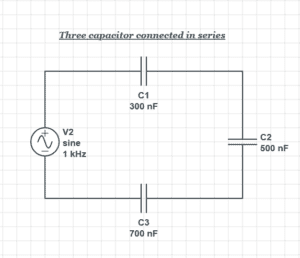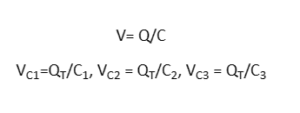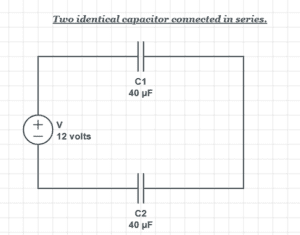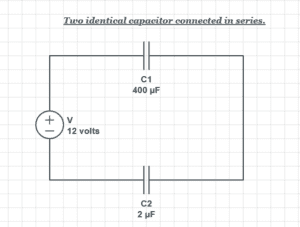What is Mean by Capacitor
(capacitor in series)
Capacitor is one of the important components in the three electronic components which make up the fundamentals of electrical circuits. The other two components are the resistor and inductor. Capacitor is a device that stores electrical charge. When voltage is supplied to it holds electrical charge and discharge itself when the circuit needs electrical charge.
Capacitors are constructed from parallel plates which are called metallic plates, and these plates are separated from each other with dielectric medium. When voltage is applied to the capacitor the positive terminal is charged positively and the negative terminal is charged negatively.
Capacitance
(capacitor in series)
Voltage or potential difference is caused due to the charge accumulation on the plates of the capacitor. The amount of charge accumulated in the capacitor produces electrical voltage. The capacitance is the property of charge holding capacity of the capacitor. The capability of the capacitor is measured in capacitance. The capacitance is referred to as the charge stored in the capacitor to produce 1 volt of potential difference.
Due to the direct relationship between charge and voltage in the capacitor. So, the charge is directly proportional to the voltage.
Here Q is charge, V is voltage and C is constant.
Here A is the area of plates, d is the distance between plates and E is the permeability.
Capacitors in series Connection
Capacitors are in series when they are connected as chain pattern. In series connection the current flowing through capacitor is same because it has only one path to flow. As there is the same current in all capacitors, the total current is equal to the sum of individual current. Due to the same amount of current in each capacitor, the same amount of charge will store in each capacitor.
Total current in series connection is.
Total charge in series connection is
Let’s take the example of a circuit in which three capacitors are connected in series. The capacitors are C1, C2, and C3.
Capacitor in series
In parallel circuit the total capacitance is equal to the sum of individual capacitor capacitance in the circuit. But in series connection the capacitance of the circuit is calculated differently. Total capacitance is denoted by CT.
In series circuit the capacitators are connected like the 2nd plate of first capacitor is connected to the first plate of second capacitor and so on. Let’s take the above example, there are three capacitor C1, C2 and C3. The second plate of first capacitor is connected to the first plate of the second capacitor and the first plate of the second capacitor is connected to the first plate of the third capacitor and the first plate of the first capacitor and the second plate of the third capacitor is connected to the voltage source.
In the above example the second capacitor (C2) totally isolated from the circuit due to which the plate area is decrease therefore the voltage drops in the circuit will be different. It will depend upon the value of the capacitors.
Now, Apply Kirchhoff’s voltage law to the above circuit.
Let’s suppose the source voltage is 12 volts.
So,
Arrange for V
Equation for series capacitor connection
Capacitors in series are just like resistors in parallel that is the reciprocal of each capacitor are added together.
The total capacitance of the capacitors in series connection will be less than the smallest value of the capacitor in the circuit. Now if only two capacitors are there in the circuit, then there is a simple formula for it to solve this. that as multiply both capacitors and divide it by sum of both capacitors.
Formula is.
Now if there are two capacitors are on the circuit of same value then to simplify further it use this method.
If
It means if two capacitors are connected in series its capacitance will be equal to half of the total capacitance.
In series connection the sum of all voltage drops in capacitors is equal to the applied voltage as like resistors connected in series.
The capacitive reactance of the capacitor acts like an impedance because of frequency. The capacitors which are connected in series act like a capacitive voltage divider network. It is a Capacitive reactance which produce voltage drop in the network.
Voltage divider formula for capacitors is just like used for resistor.
VCX is the voltage drops in the capacitors.
VS is the supply voltage.
CX is the capacitance of the capacitor.
If the value of the capacitor is same the supplied voltage will be divided equally in the capacitors, because each capacitor shares equal amount of charge in the circuit and that will be equal to half of the supplied voltage.
Now if the capacitor’s value is different from each other’s then the large value capacitor will draw low value of the voltage and the small value capacitor will draw large value of the voltage. This difference of the voltage maintains the total amount of the charge in the circuit.
Application of capacitor in series connection
- Safety: It is used to minimize the risk of shock by reducing the voltage in a circuit.
- Analysis: in series connection, each capacitor stores equal amount of charge which means total charge is equally distributed.
- High working voltage: it is used to increase the level of voltage.
- Capacitive voltage divider: it is used as a voltage divider to divide voltage into several voltage outputs.
In series connection capacitor have different advantages and disadvantages.
Advantage of Capacitor in Series connection
- It can handle higher voltage than an individual voltage.
- It can be used as a voltage divider to divide voltage into several outputs.
- Each capacitor can store an equal amount of charge and they are distributed equally in series connection.
Disadvantage of Capacitor in Series connection
- Its equivalent capacitance is low in series connection.
- Its capacity of storing energy is lower in series connection than individual.
- In series connection the risk of failure of capacitor is high than the individual.
Example on Capacitor in Series
Taking an example of the above circuit, there are three capacitors C1 = 0.3µF (300nF), C2 = 0.5µF (500nF), And C3 = 0.7µF (700nF). Find total capacitance (CT) of the capacitors connected in the circuit.
Example on Capacitor in Series
Let’s take another example.
Find overall capacitance and individual rms voltage drops when two capacitors are connected in series to 12 volts supply voltage.
- The capacitance of both capacitor is 40µF.
- When 400µF capacitor is connected in series with 2µF.
Find total capacitance.
Now
To find voltage drops in two same 40µF capacitors.
 Now to find unequal capacitance
Now to find unequal capacitance
Now find voltage drops across two non-identical capacitors.
For capacitor C1
Frequently asked question FAQs
Q 1: Why each capacitor stores equal amount of charge in series connection:
Ans: because the charge stored in the plate of one capacitor comes from the plates of the adjected capacitor.
Q2: When two capacitor C1 and C2 are connected in series what will be the total capacitance?
Ans: when two capacitors are connected in series the total capacitance will be:
Formula is,
1/C = 1/C1 + 1/C2
Here C in the equation represents the capacitance of the capacitor.
Q3: when N capacitors are connected in series having capacitance C, find equivalent capacitance?
Ans: the equivalent capacitance of the N capacitor having capacitance C and connected in series will be find with the help of the following formula.
Ceq = C / N.
Ceq represents the equivalent capacitance.
Q4: what is the equivalent capacitance of the capacitor when connected in series connection?
Ans: the equivalent capacitance of the capacitor connected in series connection will be the sum of the individual capacitance of the capacitor. The total capacitance can be calculated with the help of the following formula.
1/Ceq = 1/C1 + 1/C2 + 1/C3 + … + 1/Cn
C1,C2,C3 represent the individual capacitance of the capacitor and Ceq Represent the total capacitance of the capacitor.
Q5: what is the equivalent capacitance of the capacitor when connected in parallel connection?
Ans: the equivalent capacitance of the capacitor connected in series connection will be the sum of the individual capacitance of the capacitor. The total capacitance can be calculated with the help of the following formula.
Ceq = C1 + C2 + C3 + … + Cn
C1,C2,C3 represent the individual capacitance of the capacitor and Ceq Represent the total capacitance of the capacitor.
Q6: what is the formula to find equivalent capacitance?
Ans: the formula for equivalent capacitance is:
1/Ceq = 1/C1 + 1/C2 + 1/C3 + … + 1/Cn
Q7: what is the formula to find equivalent capacitance in parallel connection?
Ans: the formula to find equivalent capacitance in parallel connection is:
Ceq = C1 + C2 + C3 + … + Cn
Q8: give any of the two uses of capacitor?
Ans: there are the two uses of capacitor:
- It can store electric charge.
- It can control current in the circuit.
Q9: what is the SI (system international) unit of the capacitor?
Ans: the SI (system international) unit of the capacitor is Farad which denoted by (F).
Q10: energy stored in a capacitor in which form?
Ans: energy is stored in the capacitor in the form electrical field.
See Also:
- Types of resistors
- electrical current
- electrical voltage
- current vs voltage
- largest hydropower plant in the world
- nuclear power plant
- N type semiconductor
- P type semiconductor
- types of inductors
- types of insulators
- thin film resistor
- color coded resistors
- current divider rule
- voltage divider rule
- battery tester
- types of electric current
- manifold absolute pressure (MAP)





3 thoughts on “Capacitor in Series, Application, Advantage and Disadvantage”